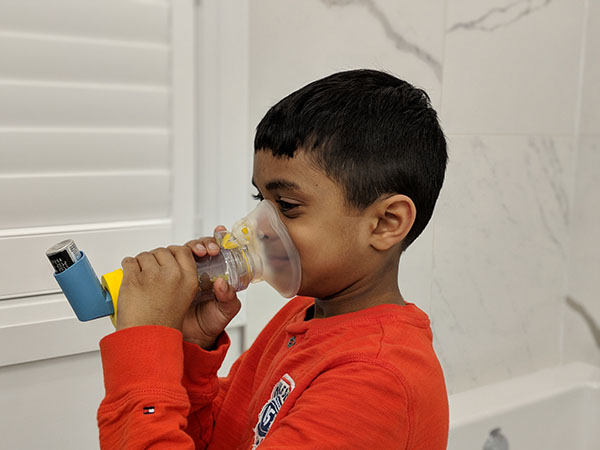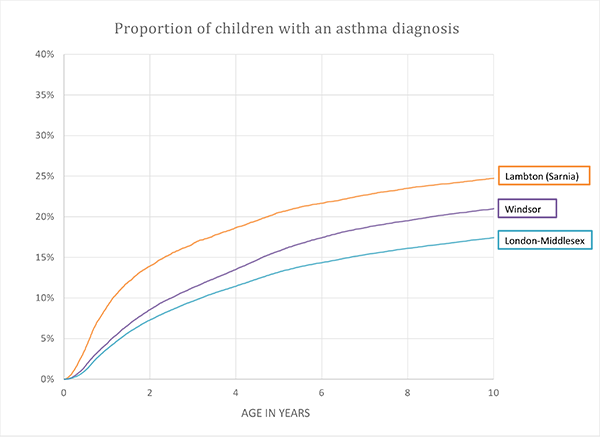

LONDON, ON – New findings from Ontario have shown that children born in Sarnia have a higher risk of developing asthma compared to neighbouring cities. A research team from Lawson Health Research Institute and Western University, using provincial data from ICES, found that higher air pollution exposure in the first year of life very likely contributed to this higher risk. Their results are published today in CMAJ Open.
“It’s known that cities in Southwestern Ontario have varied levels of air pollution because of differences in industry and traffic. For example, Sarnia is home to the ‘Chemical Valley’ where numerous chemical plants and oil refineries are clustered,” says Dr. Dhenuka Radhakrishnan, an Adjunct ICES Scientist, formerly working out of ICES Western in London, and Pediatric Respirologist at CHEO. “We wanted to see if children born in three cities – London, Windsor and Sarnia – had a different risk of developing asthma due to the differing air pollution levels in the three regions, even though the people living in these cities are otherwise comparable in many ways.”
The researchers followed 114,427 children born in these cities between 1993 and 2009 for 10 years, and found that those in Sarnia were at the highest risk of developing asthma. The researchers found that by the age of 10, nearly 24 per cent of children in Sarnia were diagnosed with asthma, compared to 21 per cent in Windsor and 17 per cent in London. The differences were also present after accounting for many risk factors associated with asthma, such as sex, socioeconomic status and urban versus rural setting. The findings were most apparent in the first two years of life, but persistent beyond the age of six.
“Reassuringly, we found the asthma risk for children has reduced in more recent years as pollution levels have also decreased,” adds Dr. Radhakrishnan.
Asthma is the most common chronic disease in Canadian children and has significant impact on quality of life. Asthma is the leading cause of emergency department visits and hospital admissions in this age group.
“It’s important to find strategies to prevent asthma development and this study suggests that reducing air pollution exposure, including environmental causes, might reduce the number of children who suffer from asthma,” explains Dr. Salimah Shariff, Associate Scientist at Lawson, Adjunct Professor at Western and Scientist at ICES Western.
There is also growing evidence that exposure during pregnancy can influence development of asthma in children. “We need to carefully examine how reducing air pollution exposures within a geographic area translates to reductions in asthma development. Understanding the amount of air pollution that a mother and infant are exposed to, and how this impacts their personal risk, could enable regions to target safer levels for their residents,” adds Dr. Shariff.
Wednesday, May 5 is World Asthma Day (WAD). Recognizing symptoms of asthma early is the best a parent can do to improve the health of their child, so they can be diagnosed quickly and start appropriate treatments. If a parent notices their child has wheezing, persistent cough or difficulty with exercise, they are encouraged to bring this to the attention of a health care provider.
-30-
DOWNLOADABLE MEDIA

Child using an age-appropriate valved spacer device with an asthma inhaler. They should be used together for children to ensure the medication is properly delivered to the lungs.

Child using an age-appropriate valved spacer device with an asthma inhaler. They should be used together for children to ensure the medication is properly delivered to the lungs.

Dr. Dhenuka Radhakrishnan, an Adjunct ICES Scientist, formerly working out of ICES Western in London, and Pediatric Respirologist at CHEO

Dr. Salimah Shariff, Associate Scientist at Lawson, Adjunct Professor at Western and Scientist at ICES Western

Proportion of children with an asthma diagnosis by studied region
Lawson Health Research Institute is one of Canada’s top hospital-based research institutes, tackling the most pressing challenges in health care. As the research institute of London Health Sciences Centre and St. Joseph’s Health Care London, our innovation happens where care is delivered. Lawson research teams are at the leading-edge of science with the goal of improving health and the delivery of care for patients. Working in partnership with Western University, our researchers are encouraged to pursue their curiosity, collaborate often and share their discoveries widely. Research conducted through Lawson makes a difference in the lives of patients, families and communities around the world. To learn more, visit www.lawsonresearch.ca.
Western delivers an academic experience second to none. Since 1878, The Western Experience has combined academic excellence with life-long opportunities for intellectual, social and cultural growth in order to better serve our communities. Our research excellence expands knowledge and drives discovery with real-world application. Western attracts individuals with a broad worldview, seeking to study, influence and lead in the international community.
The Institute for Clinical Evaluative Sciences (ICES) is an independent, non-profit organization that uses population-based health information to produce knowledge on a broad range of health care issues. Our unbiased evidence provides measures of health system performance, a clearer understanding of the shifting health care needs of Ontarians, and a stimulus for discussion of practical solutions to optimize scarce resources. ICES knowledge is highly regarded in Canada and abroad, and is widely used by government, hospitals, planners, and practitioners to make decisions about care delivery and to develop policy. For the latest ICES news, follow us on Twitter: @ICESOntario
Communications Consultant & External Relations
Lawson Health Research Institute
T: 519-685-8500 ext. 75664
C. 519-619-3872
@email